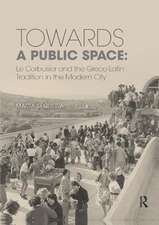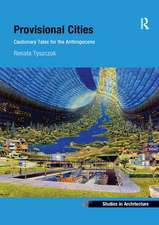John Ruskin and the Fabric of Architecture
Autor Anuradha Chatterjeeen Limba Engleză Hardback – 29 sep 2017
John Ruskin and the Fabric of Architecture examines the ways in which Ruskin perceives the evolution of architecture through the idea that architecture is surface. The creative act in architecture, analogous to the divine act of creation, was viewed as a form of dressing. By adding highly aesthetic features to designs, taking inspiration from the 'veil' of women’s clothing, Ruskin believed that buildings could be transformed into meaningful architecture. This volume discusses the importance of Ruskin’s surface theory and the myth of feminine architecture, and additionally presents a competing theory of textile analogy in architecture based on morality and gender to counter Gottfried Semper’s historicist perspective.
This book would be beneficial to students and academics of architectural history and theory, gender studies and visual studies who wish to delve into Ruskin’s theories and to further understand his capacity for thinking beyond the historical methods. The book will also be of interest to architectural practitioners, particularly Ruskin’s theory of surface architecture.
| Toate formatele și edițiile | Preț | Express |
|---|---|---|
| Paperback (1) | 416.22 lei 6-8 săpt. | |
| Taylor & Francis – 17 ian 2019 | 416.22 lei 6-8 săpt. | |
| Hardback (1) | 764.51 lei 6-8 săpt. | |
| Taylor & Francis – 29 sep 2017 | 764.51 lei 6-8 săpt. |
Preț: 764.51 lei
Preț vechi: 1102.96 lei
-31% Nou
Puncte Express: 1147
Preț estimativ în valută:
146.29€ • 153.29$ • 120.93£
146.29€ • 153.29$ • 120.93£
Carte tipărită la comandă
Livrare economică 11-25 aprilie
Preluare comenzi: 021 569.72.76
Specificații
ISBN-13: 9781472449436
ISBN-10: 1472449436
Pagini: 156
Ilustrații: 45
Dimensiuni: 174 x 246 x 15 mm
Greutate: 0.47 kg
Ediția:1
Editura: Taylor & Francis
Colecția Routledge
Locul publicării:Oxford, United Kingdom
ISBN-10: 1472449436
Pagini: 156
Ilustrații: 45
Dimensiuni: 174 x 246 x 15 mm
Greutate: 0.47 kg
Ediția:1
Editura: Taylor & Francis
Colecția Routledge
Locul publicării:Oxford, United Kingdom
Cuprins
Introduction: John Ruskin and the space of surface 1.Ruskin's theory of the wall (veil) 2.Architecture as dressed female body 3.Ruskin's theory of dress 4.The adorned edifice(s) 5.Ruskin effects
Notă biografică
Anuradha Chatterjee (PhD) is Professor and Dean, Faculty of Design, Manipal University Jaipur. She is a registered architect in India, with M. Arch and PhD from the University of New South Wales, Australia. Prior to joining Manipal University Jaipur, Dr Chatterjee was the Dean Academics at Avani Institute of Design, where she was responsible for establishing culture and systems for academic excellence. Dr Chatterjee is the Regional Editor (Asia Pacific) at Taylor and Francis journal Textile: Journal of Cloth and Culture, and she is the Area Editor for Asia, Bloomsbury Global Encyclopedia of Women in Architecture 1960-2015 (edited by Karen Burns and Lori Brown, forthcoming in 2021).
Recenzii
"The idea of the wall-veil is foremost in Ruskin’s vison of architecture, yet remains – intentionally – mysterious. This concentrated study re–veals its latent, layered meanings, unpicking Ruskin’s dress-codes in their various aspects of soul, body, the femininity of architecture, and so forth. Close intra-textual and inter-textual readings skilfully place these notions in the context, both of Ruskin’s own multi-faceted volumes, and of other works of inspiration and commentary – notably the philosophy of clothes of Thomas Carlyle’s Sartor Resartus"
Stephen Kite, Professor, Welsh School of Architecture, Cardiff University, Wales, UK
"What a terrific book! It is of such high quality, both text and stunning illustrations. It is a fascinating Ruskinian architectural journey through France and Italy. The book gives us new eyes to see old architecture that we are so familiar with, yet do not see! And I like the fact that in the last chapter, the author brings it up to date with Ruskin and modern architecture."
Cynthia Gamble, Honorary Research Fellow, University of Exeter; Author of Proust as Interpreter of Ruskin: The Seven Lamps of Translation; and Former Chairman of the Ruskin Society.
"John Ruskin and the Fabric of Architecture insightfully revisits the Ruskin’s writings on architecture to demonstrate his vision of walls as surface. By engaging in a novel multidisciplinary approach at the intersection of surface, gender and dress studies, Anuradha Chatterjee revises long held assumptions about Ruskin’s architectural theories and their impact on nineteenth and twentieth centuries. Her richly illustrated monograph will be of enduring interest for Ruskin scholars, architectural historians and Victorianists."
Bénédicte Coste, University of Burgundy, France
"Writing about Ruskin is always over-shadowed by his demands for truth in art and his own manifest contradictions and prolixity. How then to understand the enduring value of his work without deadening it in explanation? Anuradha Chatterjee can guide us in this. Her subtle grasp of Ruskin’s formal values comes as much from her own architectural intuition as from her ability to dive in and out of Ruskin’s oeuvre and the sea of secondary literature. Chatterjee has a real feeling for the thickness that gender, semantics and the will to adorn give to the material facts of the building’s skin. There are many truths to be had from Ruskin, and this book shows us one of these."
John Macarthur, Professor and Director of the research centre for Architecture, Theory, Criticism and History, University of Queensland
"The textual delicacy of Anuradha Chatterjee’s prose-traces is as sublime as the finest embroidered tissue. Applied to the material substance of architecture’s built form and function, her entwined gauze of words constructs a beguiling écriture féminine that articulates in triumphant whisper the dextrous joy of Ruskin’s nature and craft."
Professor Catherine Harper, Deputy Vice-Chancellor, University of Chichester, UK; Editor-in-Chief ofTextile: Cloth & Culture (Routledge).
"John Ruskin and the Fabric of Architecture is significant contribution to a long tradition of work on Ruskin’s architectural writings….Anyone tempted to undertake a European tour of Ruskinian architecture should take this book along: it would be immensely rewarding to refer to her readings in situ…This work is lively in its intellectual ambitions, reaching out beyond architecture and making a case for the broader significance of Ruskin’s architectonics, its vital interplay with all other aspects of his writings, and with a range of nineteenth-century contexts."
Mark Frost, University of Portsmouth, The Companion 2018
"2019 marks the bicentenary of John Ruskin’s birth. John Ruskin and the Fabric of Architecture, a Routledge publication (2018), authored by architectural historian Anuradha Chatterjee is timely and succeeds in firmly resurrecting Ruskin as relevant and his thought processes as timeless and thus merit deeper engagement.
This 144 pages book is dense, captivating, intriguing, illuminating and inciting. It is rigorously researched, referenced and cross referenced and yet presents a narrative that is focussed on a chosen aspect – that of façade or as Ruskin preferred ‘surface’ as architecture."
Poonam Verma Mascarenhas, practicing architect, building conservationist, researcher and writer at her Goa based award winning studio Archinova_Environs.
"Ruskin and the Fabric of Architecture provides innovative ways to think about the many connections of architecture to textile and gender and is of interest to those studying the aesthetic influences in the nineteenth century and beyond. It is also accessible for those without extensive architectural knowledge to enjoy the Ruskinian connections of art and architecture."
Ann Gagné, Pre-Raphaelite Studies
"John Ruskin and the Fabric of Architecture is a masterful defense of the enduring value of Ruskin’s theories in contemporary architectural discourse, elucidating the relationship between Ruskin’s theories and dress, gender, science, and visual studies, one which testifies to the enduring relevance of Ruskinian thought in bracingly fresh and illuminating ways."
T. B. Kennedy, architectural historian, preservationist, and writer
Stephen Kite, Professor, Welsh School of Architecture, Cardiff University, Wales, UK
"What a terrific book! It is of such high quality, both text and stunning illustrations. It is a fascinating Ruskinian architectural journey through France and Italy. The book gives us new eyes to see old architecture that we are so familiar with, yet do not see! And I like the fact that in the last chapter, the author brings it up to date with Ruskin and modern architecture."
Cynthia Gamble, Honorary Research Fellow, University of Exeter; Author of Proust as Interpreter of Ruskin: The Seven Lamps of Translation; and Former Chairman of the Ruskin Society.
"John Ruskin and the Fabric of Architecture insightfully revisits the Ruskin’s writings on architecture to demonstrate his vision of walls as surface. By engaging in a novel multidisciplinary approach at the intersection of surface, gender and dress studies, Anuradha Chatterjee revises long held assumptions about Ruskin’s architectural theories and their impact on nineteenth and twentieth centuries. Her richly illustrated monograph will be of enduring interest for Ruskin scholars, architectural historians and Victorianists."
Bénédicte Coste, University of Burgundy, France
"Writing about Ruskin is always over-shadowed by his demands for truth in art and his own manifest contradictions and prolixity. How then to understand the enduring value of his work without deadening it in explanation? Anuradha Chatterjee can guide us in this. Her subtle grasp of Ruskin’s formal values comes as much from her own architectural intuition as from her ability to dive in and out of Ruskin’s oeuvre and the sea of secondary literature. Chatterjee has a real feeling for the thickness that gender, semantics and the will to adorn give to the material facts of the building’s skin. There are many truths to be had from Ruskin, and this book shows us one of these."
John Macarthur, Professor and Director of the research centre for Architecture, Theory, Criticism and History, University of Queensland
"The textual delicacy of Anuradha Chatterjee’s prose-traces is as sublime as the finest embroidered tissue. Applied to the material substance of architecture’s built form and function, her entwined gauze of words constructs a beguiling écriture féminine that articulates in triumphant whisper the dextrous joy of Ruskin’s nature and craft."
Professor Catherine Harper, Deputy Vice-Chancellor, University of Chichester, UK; Editor-in-Chief ofTextile: Cloth & Culture (Routledge).
"John Ruskin and the Fabric of Architecture is significant contribution to a long tradition of work on Ruskin’s architectural writings….Anyone tempted to undertake a European tour of Ruskinian architecture should take this book along: it would be immensely rewarding to refer to her readings in situ…This work is lively in its intellectual ambitions, reaching out beyond architecture and making a case for the broader significance of Ruskin’s architectonics, its vital interplay with all other aspects of his writings, and with a range of nineteenth-century contexts."
Mark Frost, University of Portsmouth, The Companion 2018
"2019 marks the bicentenary of John Ruskin’s birth. John Ruskin and the Fabric of Architecture, a Routledge publication (2018), authored by architectural historian Anuradha Chatterjee is timely and succeeds in firmly resurrecting Ruskin as relevant and his thought processes as timeless and thus merit deeper engagement.
This 144 pages book is dense, captivating, intriguing, illuminating and inciting. It is rigorously researched, referenced and cross referenced and yet presents a narrative that is focussed on a chosen aspect – that of façade or as Ruskin preferred ‘surface’ as architecture."
Poonam Verma Mascarenhas, practicing architect, building conservationist, researcher and writer at her Goa based award winning studio Archinova_Environs.
"Ruskin and the Fabric of Architecture provides innovative ways to think about the many connections of architecture to textile and gender and is of interest to those studying the aesthetic influences in the nineteenth century and beyond. It is also accessible for those without extensive architectural knowledge to enjoy the Ruskinian connections of art and architecture."
Ann Gagné, Pre-Raphaelite Studies
"John Ruskin and the Fabric of Architecture is a masterful defense of the enduring value of Ruskin’s theories in contemporary architectural discourse, elucidating the relationship between Ruskin’s theories and dress, gender, science, and visual studies, one which testifies to the enduring relevance of Ruskinian thought in bracingly fresh and illuminating ways."
T. B. Kennedy, architectural historian, preservationist, and writer
Descriere
Through the lenses of dress studies, gender and visual studies, this volume assembles Ruskin’s theory of surface architecture, or the "wall veil." This book positions Ruskin as having proposed an unorthodox definition of architecture as surface, highlighting his major contribution and an important moment in the history of architectural modernity.




















